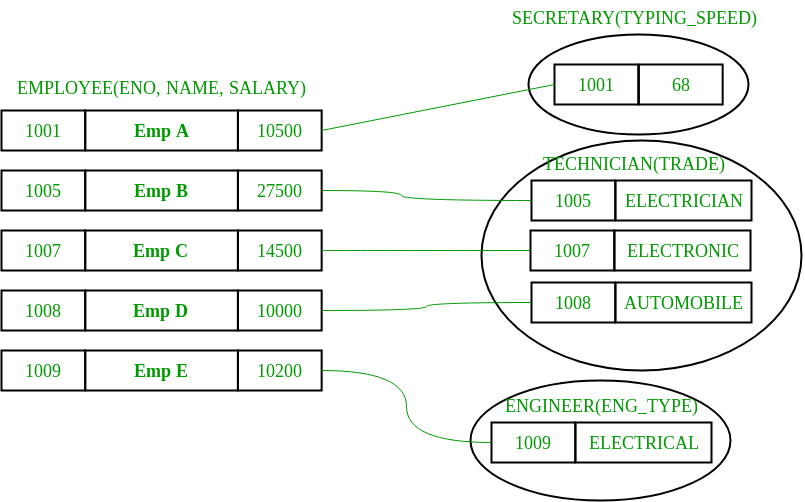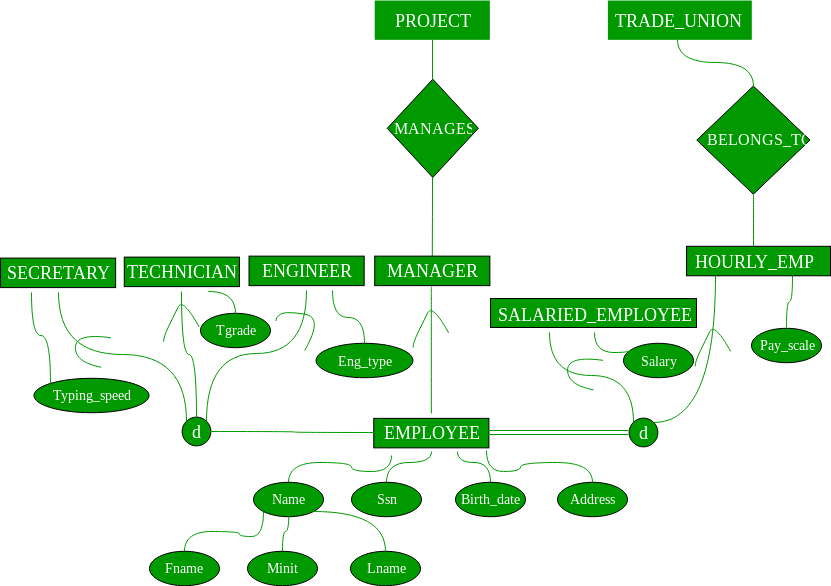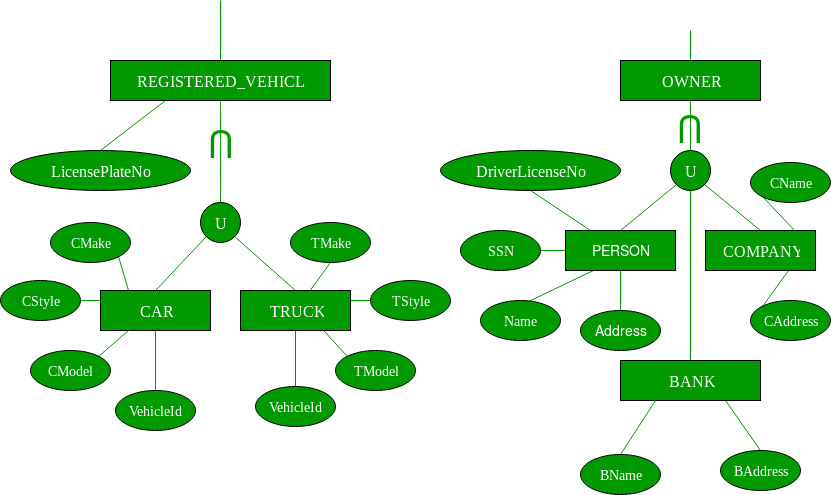Enhanced ER Model
Last Updated :
15 Mar, 2023
Prerequisite – Introduction of ER Model
Today the complexity of the data is increasing so it becomes more and more difficult to use the traditional ER model for database modeling. To reduce this complexity of modeling we have to make improvements or enhancements to the existing ER model to make it able to handle the complex application in a better way.
Enhanced entity-relationship diagrams are advanced database diagrams very similar to regular ER diagrams which represent the requirements and complexities of complex databases.
It is a diagrammatic technique for displaying the Sub Class and Super Class; Specialization and Generalization; Union or Category; Aggregation etc.
Generalization and Specialization: These are very common relationships found in real entities. However, this kind of relationship was added later as an enhanced extension to the classical ER model. Specialized classes are often called subclass while a generalized class is called a superclass, probably inspired by object-oriented programming. A sub-class is best understood by “IS-A analysis”. The following statements hopefully make some sense to your mind “Technician IS-A Employee”, and “Laptop IS-A Computer”.
An entity is a specialized type/class of another entity. For example, a Technician is a special Employee in a university system Faculty is a special class of Employees. We call this phenomenon generalization/specialization. In the example here Employee is a generalized entity class while the Technician and Faculty are specialized classes of Employee.
Example:
This example instance of “sub-class” relationships. Here we have four sets of employees: Secretary, Technician, and Engineer. The employee is a super-class of the rest three sets of individual sub-class is a subset of Employee set.

- An entity belonging to a sub-class is related to some super-class entity. For instance emp, no 1001 is a secretary, and his typing speed is 68. Emp no 1009 is an engineer (sub-class) and her trade is “Electrical”, so forth.
- Sub-class entity “inherits” all attributes of super-class; for example, employee 1001 will have attributes eno, name, salary, and typing speed.
Enhanced ER model of above example

Constraints – There are two types of constraints on the “Sub-class” relationship.
- Total or Partial – A sub-classing relationship is total if every super-class entity is to be associated with some sub-class entity, otherwise partial. Sub-class “job type based employee category” is partial sub-classing – not necessary every employee is one of (secretary, engineer, and technician), i.e. union of these three types is a proper subset of all employees. Whereas other sub-classing “Salaried Employee AND Hourly Employee” is total; the union of entities from sub-classes is equal to the total employee set, i.e. every employee necessarily has to be one of them.
- Overlapped or Disjoint – If an entity from a super-set can be related (can occur) in multiple sub-class sets, then it is overlapped sub-classing, otherwise disjoint. Both the examples: job-type based and salaries/hourly employee sub-classing are disjoint.
Note – These constraints are independent of each other: can be “overlapped and total or partial” or “disjoint and total or partial”. Also, sub-classing has transitive properties.
Multiple Inheritance (sub-class of multiple superclasses) –
An entity can be a sub-class of multiple entity types; such entities are sub-class of multiple entities and have multiple super-classes; Teaching Assistant can subclass of Employee and Student both. A faculty in a university system can be a subclass of Employee and Alumnus. In multiple inheritances, attributes of sub-class are the union of attributes of all super-classes.
Union –
- Set of Library Members is UNION of Faculty, Student, and Staff. A union relationship indicates either type; for example, a library member is either Faculty or Staff or Student.
- Below are two examples that show how UNION can be depicted in ERD – Vehicle Owner is UNION of PERSON and Company, and RTO Registered Vehicle is UNION of Car and Truck.

You might see some confusion in Sub-class and UNION; consider an example in above figure Vehicle is super-class of CAR and Truck; this is very much the correct example of the subclass as well but here use it differently we are saying RTO Registered vehicle is UNION of Car and Vehicle, they do not inherit any attribute of Vehicle, attributes of car and truck are altogether independent set, where is in sub-classing situation car and truck would be inheriting the attribute of vehicle class.
An Enhanced Entity-Relationship (EER) model is an extension of the original Entity-Relationship (ER) model that includes additional concepts and features to support more complex data modeling requirements. The EER model includes all the elements of the ER model and adds new constructs, such as subtypes and supertypes, generalization and specialization, and inheritance.
Here are some of the key features of the EER model:
- Subtypes and Supertypes: The EER model allows for the creation of subtypes and supertypes. A supertype is a generalization of one or more subtypes, while a subtype is a specialization of a supertype. For example, a vehicle could be a supertype, while car, truck, and motorcycle could be subtypes.
- Generalization and Specialization: Generalization is the process of identifying common attributes and relationships between entities and creating a supertype based on these common features. Specialization is the process of identifying unique attributes and relationships between entities and creating subtypes based on these unique features.
- Inheritance: Inheritance is a mechanism that allows subtypes to inherit attributes and relationships from their supertype. This means that any attribute or relationship defined for a supertype is automatically inherited by all its subtypes.
- Constraints: The EER model allows for the specification of constraints that must be satisfied by entities and relationships. Examples of constraints include cardinality constraints, which specify the number of relationships that can exist between entities, and participation constraints, which specify whether an entity is required to participate in a relationship.
- Overall, the EER model provides a powerful and flexible way to model complex data relationships, making it a popular choice for database design. An Enhanced Entity-Relationship (EER) model is an extension of the traditional Entity-Relationship (ER) model that includes additional features to represent complex relationships between entities more accurately. Some of the main features of the EER model are:
- Subclasses and Superclasses: EER model allows for the creation of a hierarchical structure of entities where a superclass can have one or more subclasses. Each subclass inherits attributes and relationships from its superclass, and it can also have its unique attributes and relationships.
- Specialization and Generalization: EER model uses the concepts of specialization and generalization to create a hierarchy of entities. Specialization is the process of defining subclasses from a superclass, while generalization is the process of defining a superclass from two or more subclasses.
- Attribute Inheritance: EER model allows attributes to be inherited from a superclass to its subclasses. This means that attributes defined in the superclass are automatically inherited by all its subclasses.
- Union Types: EER model allows for the creation of a union type, which is a combination of two or more entity types. The union type can have attributes and relationships that are common to all the entity types that make up the union.
- Aggregation: EER model allows for the creation of an aggregate entity that represents a group of entities as a single entity. The aggregate entity has its unique attributes and relationships.
- Multi-valued Attributes: EER model allows an attribute to have multiple values for a single entity instance. For example, an entity representing a person may have multiple phone numbers.
- Relationships with Attributes: EER model allows relationships between entities to have attributes. These attributes can describe the nature of the relationship or provide additional information about the relationship.
Overall, these features make the EER model more expressive and powerful than the traditional ER model, allowing for a more accurate representation of complex relationships between entities.
Like Article
Suggest improvement
Share your thoughts in the comments
Please Login to comment...